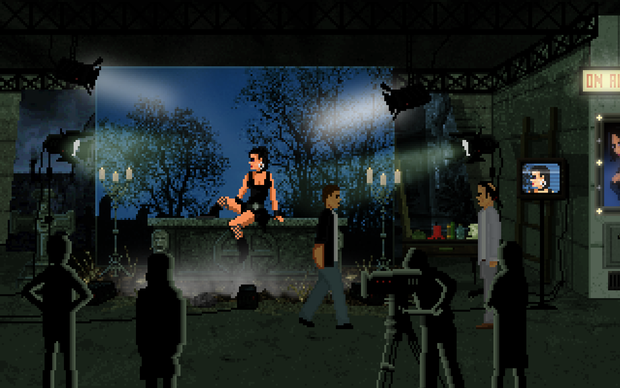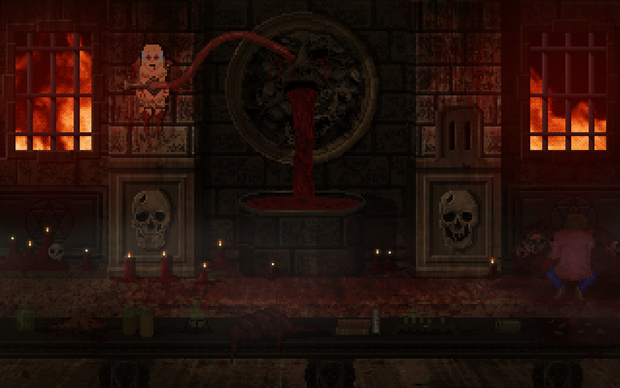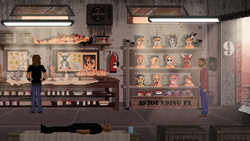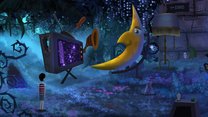Nightmare Frames review – Retro point-and-clicker a cheesy 80s horror movie buff's dream

- 0 Comments
What would you do to achieve ultimate success? Move to a different city, away from all your friends? Spend all your time in the office, neglecting your family? How about giving up your firstborn child, or maybe selling your soul? In Postmodern Adventures’ Nightmare Frames, you’ll help a horror movie screenwriter weigh exactly what he’s willing to do to succeed beyond his wildest dreams. His journey through this retro-styled point-and-click pixel art adventure can be overly complicated at times, but it’s ultimately one that will have you settling down with some popcorn to enjoy the show.
The scene is mid-1980s Los Angeles. Amid sultry palm trees and traffic-choked streets, Alan Goldberg is searching for more meaning in life than penning grisly horror film plots…. But let’s rewind the videotape a bit and start off in a darkly pixelated woodland setting. Nightmare Frames opens with a pretty gory set piece, with a few well-placed pixels on a screen showing the terror of an eviscerated man swinging from a tree – a brutal scene that turns out to be ripped straight from the imaginings of our jaded Hollywood scriptwriter, Alan.
Alan has “made it” by writing popular 80s slasher flicks, with names like “President’s Day Killer (It’s Time to Vote!)” and “Don’t Go Into the Forest (3D).” He’s currently trying to overcome writer’s block with the sequel to the wildly successful “Lunatic.” Despite his accomplishments, what Alan really wants to do is write serious dramas, like his previous film, “Melodies of Heaven,” which garnered him an Oscar nomination. But he has to put his dreams of creating prestige dramas on hold since the studio heads would rather he focus on guaranteed money-makers. Of course, this doesn’t suit Alan at all, given that he thinks so much of his horror movie accolades that he is currently using the award given to him for “Campfire Psycho” as a doorstop.
A man of many facets, Alan is described by people as a reactionary (well, that’s what you get when you put one right-wing killer in a movie, he notes) and he harbors strong, sometimes uninformed opinions, so much so that he’s received death threats after criticizing a beloved TV show host. He doesn’t seem to have much luck with his relationships, given that the cook at a local diner insults him for his treatment of an old flame. All in all, he seems like a pretty typical misanthrope who is kind of rootless.

It turns out Alan doesn’t have much time to worry about his writer’s block, because the sudden death of one of his supporters in the upper echelons of the movie business sets off a chain of events that leads to Alan getting a message from a mysterious benefactor. This fabulously wealthy woman wants him to find an obscure never-before-seen horror film from a directing legend, Edward Keller, who directed “Bloody Mind Games,” a movie that scared the pants off of millions. Keller, a man described as “the JD Salinger of horror,” disappeared into obscurity, after hinting at wanting to create something that would be the most terrifying movie ever made.
Alan’s search for the mother of all horror movies leads him to a town where it never stops raining, Serena. This is a place where everyone has experienced tragedy in one form or another, from terrible high school fires to missing children ranging from decades ago to recent times. Town residents have a variety of theories as to why Serena is besieged by awfulness and why they have a penchant for seeing ghostly figures. But Alan is determined to stay logical and figure out how on earth all of this has anything to do with Keller’s last movie.
The developers have stuffed this little game with wonderful details that really set the mood. The game is chock full of movie trivia, like the fact that Alan types out his manuscripts on a Loyal Olivetti Lettera 32, the same typewriter that Coppola used to write The Godfather, and that a studio executive’s mansion is named “Ankhesenamun,” a nod to the 1932 film, The Mummy. This fondness for nostalgia culminates in a playable video game at a diner, where you can choose from a selection of 80s music trivia or 80s horror movie trivia. The questions repeat, so you can play as many times as you need to finish each game and earn an achievement. I was woefully inadequate in my music insight but had a surprising well of knowledge of 80s horror films.

In addition to these details, Nightmare Frames is populated by a vast cast of characters. Alan’s world feels quite fleshed out, no pun intended, although over the course of the game, the sheer number of characters and names becomes overwhelming, with several just present as convenient plot devices to move the story along. For example, one character has what seems to be a made-up malady, chromatic anxiety, which just so happens to help you solve a puzzle later on.
You’ll meet Jack Palmer, a child star of the 30s who is now homeless and waiting outside of Alan’s movie studio; James Crosby, the vacuous blond lead of “Presidents Day Killer” (who’s now into a strange cult called the Church of Mother Earth); Chris Ruskin, the head of Ruskin Productions who wears Tox cologne (embodying both coldness and elegance); Glenn Bishop, the head of a sleazy low-budget studio making movies with subjects like women’s prison films; and Barry Mitchell, the owner of a photo studio who takes photos that could easily put him into a blackmailable position. You’ll also encounter a jaded media reporter, passionate horror make-up effects workers, an Elvira look-alike (only 80s kids will remember this!); and a doctor of natural medicine, not to mention the various taxi drivers (all with colorful personalities) who’ll transport you through town. The list goes on and on ... and that’s before we even make it to Serena, a seemingly haunted town in northern California that has another full set of its own characters.
It’s an enormous array of people, most of whom get shallow character treatment, and it makes following along with the story a bit confusing at times. The game really excels when it takes the time to get to know some of these folks better, like the affable and at times bumbling police chief, Rick Bowman, who has a complicated relationship with his daughter and ends up being braver than he or you think he could be. There is a touching moment where Alan talks Rick through a panic attack, and it seems natural and a nice character advancement for both Alan and Rick. There is also a town degenerate who has done the very worst that a human being can do and has had a religious epiphany that has you questioning how you should interact with him.

At the beginning of the game, some of the dialogue can be a bit expository and clunky. A person saying “as you wish” could have been a nod to The Princess Bride, but doesn’t really fit the scene at the time. The script does become quite humorous, however, and eventually strange and terrifying. One character nonchalantly gives you info you need before signing off with, “well, I still have to make 13 feet of intestines,” as one does.
About 99% of this dialogue is delivered through captions as there is very little voice acting (none at all for the main characters). I was pretty immersed in the bizarre story, so this never bothered me too much except at one awkward point when there is a taped interview you listen to, but it’s just sounds of static while you read captions to “hear” what the interviewee said. Otherwise, audio is used wonderfully in Nightmare Frames. Cop whistles and honking cars fill the busy L.A. streets that you walk down with life. A dispatcher can be heard over a static-crackling radio calling cops to an apparent suicide.
This energetic soundscape is complemented by retro 80s music reminiscent of Stranger Things. Red flames licking a spinning Satanic symbol at the opening of the game hints at darker themes to come. Walk into a diner with a grizzled fry cook and a world-weary waitress and you’ll hear the soothing synth tones of British 80s pop bands. At other times you’ll hear the signature 80s wail of a saxophone with the tsk, tsk, tsk of snare drums underscored with a deep bass rhythm.
A large part of your investigation involves talking to the many, many people you encounter. And you’ll need to talk to some of the characters several times, making sure you exhaust all conversation options, as not doing so may block progress at points. In addition to these dialogue explorations, there are some inventory puzzles, none of which is too punishing. I will say, though, that the most obvious inventory solution (screwdriver meet screw) is almost never the correct answer. So be prepared for a bit of frustration if your instinct is always to use the most logical object first.
Your inventory will open up at the top of the screen when you hover the cursor over it, and you’ll use your mouse to interact with the environment, with right-clicks providing observations and left-clicks allowing you to interact with hotspots if you can. In the first two-thirds of the game, you get around Los Angeles by hopping into taxis and selecting places to go. This could have been a dry device, but the taxi drivers are chatty Cathys, and they are pretty entertaining (if repetitive) if you keep backtracking, which you will if you’ve forgotten to talk to someone. Once you get to Serena, you’ll use a more conventional interactive map to quick travel to different locations.
In your travels you’ll get to explore diverse parts of L.A. and Serena. There is a lot of entertaining environmental storytelling, with horror movie posters and magazines lying around, all yielding engaging observations if you interact with them (like one magazine referring to Madonna as “this year’s music phenom” who everyone will have forgotten about a year later). The pixel art presentation is detailed and atmospheric, like the yard surrounding the mobile home trailer of a desperate man who is hoping to turn his life around. His junky yard is filled with fiberglass Virgin Mary statues both protecting his trailer and projecting his newfound religiosity to those who would try to meet with him.
Alan finds himself less and less in charge of his life as he dives deeper into the realm of uber-rich “collectors.” These cold and calculating millionaires offer up the world to poor people in order to get them to search for things that no one else has. The game lightly touches on who would and wouldn’t debase themselves for these rich people at some vague whisper of hope for a new life. Through all of this, Alan doesn’t seem to be too moved by the horrors he witnesses and puts himself through in his quest, nor does he seem to show too much introspection as to why he is in the situation he ends up in. I would have preferred more in-depth exploration of this main character other than his failed relationship and his inability to fully embrace his horror movie cred. But his lack of depth soon becomes beside the point when the game turns into a riveting interactive horror movie itself, something far more interesting than anything that Alan is described as creating.
Final Verdict
Taking about seven hours to complete, Nightmare Frames seems to have it all – maybe even too much of everything: doomsday cults, a depressed town with missing children and citizens who can’t stop seeing ghosts, millionaire collectors, pedophiles, gabby taxi drivers, serial killers, town tragedies, jump scares a plenty, and so much more. One character hits it dead on when he exclaims, “Ghosts, cannibals, what’s next?” Fortunately, while the journey is overstuffed at times, I found the final third of the game to be particularly engaging. I played through that section in one sitting because I was motivated to find out what the scariest movie in the world had to offer. In the end, though the story could have used a bit of judicious editing, it is ultimately entertaining and gripping, building to a tremendous, highly satisfying crescendo.
Hot take
It sacrifices depth for an excess of elements at times, but like the fun if cheesy 80s horror movies it emulates, Nightmare Frames becomes both scarier and more entertaining as it goes along.
Pros
- Excellent evocation of an 80s vibe through a wide variety of detailed sets and lively soundscapes
- A thrilling adventure that builds in intensity as you progress
- Peppered with some nice jump scares
Cons
- Protagonist could use a bit more character development
- Too many characters, while entertaining at times, can be hard to follow
Merlina played Nightmare Frames on PC using a review code provided by the game's publisher.

- Advertisement
- Help support AGH by advertising with us










0 Comments
Want to join the discussion? Leave a comment as guest, sign in or register.
Leave a comment